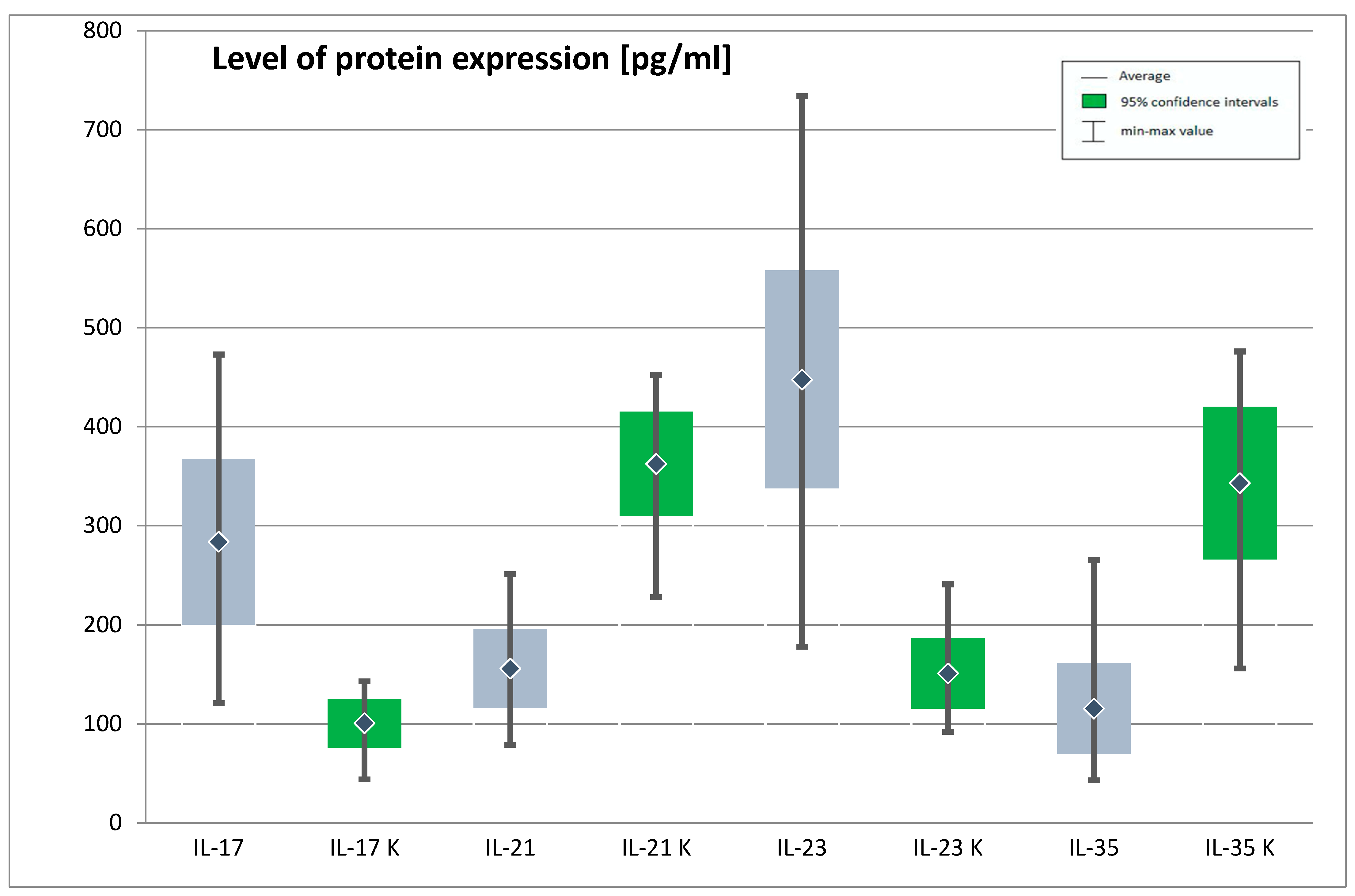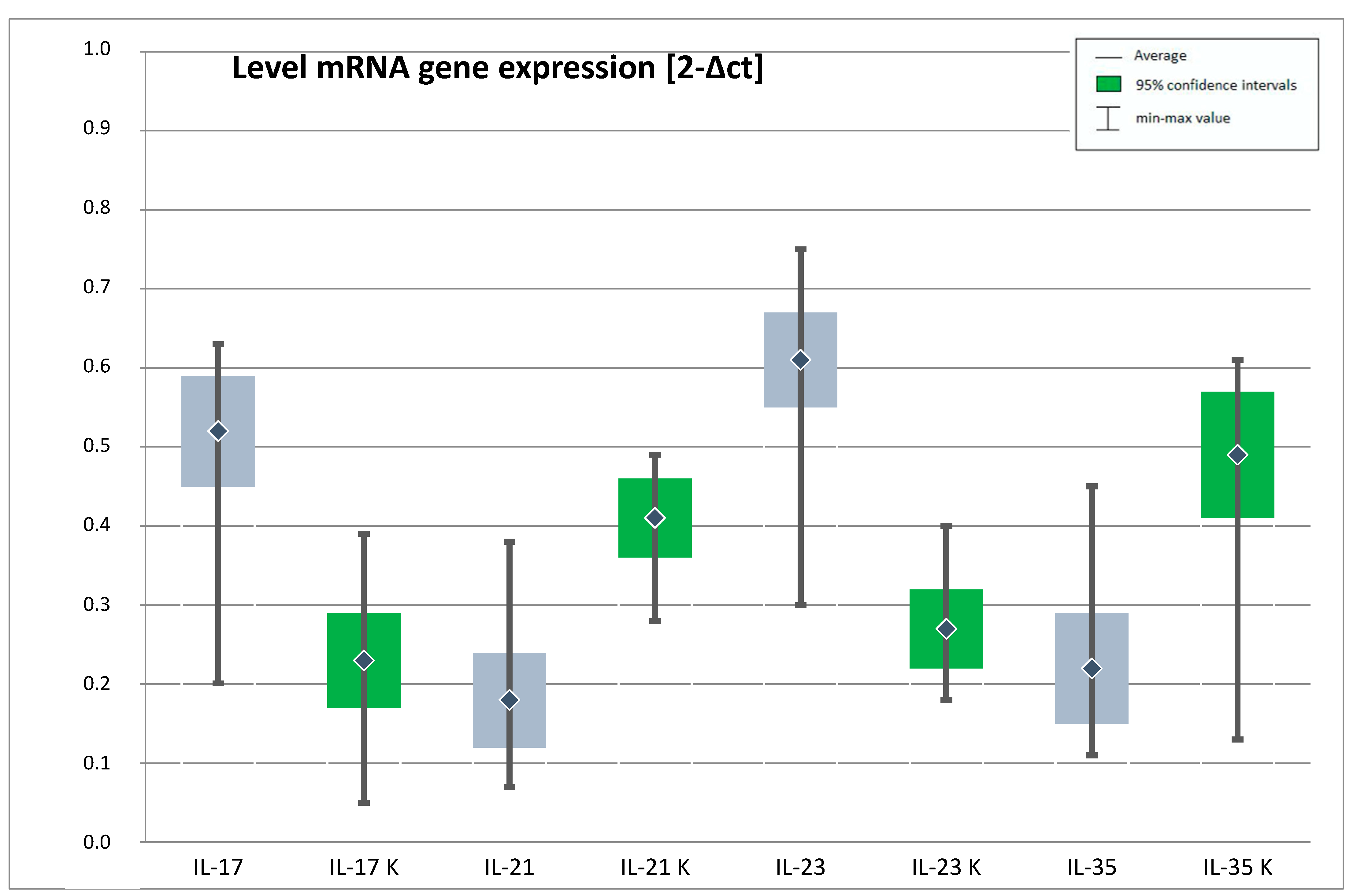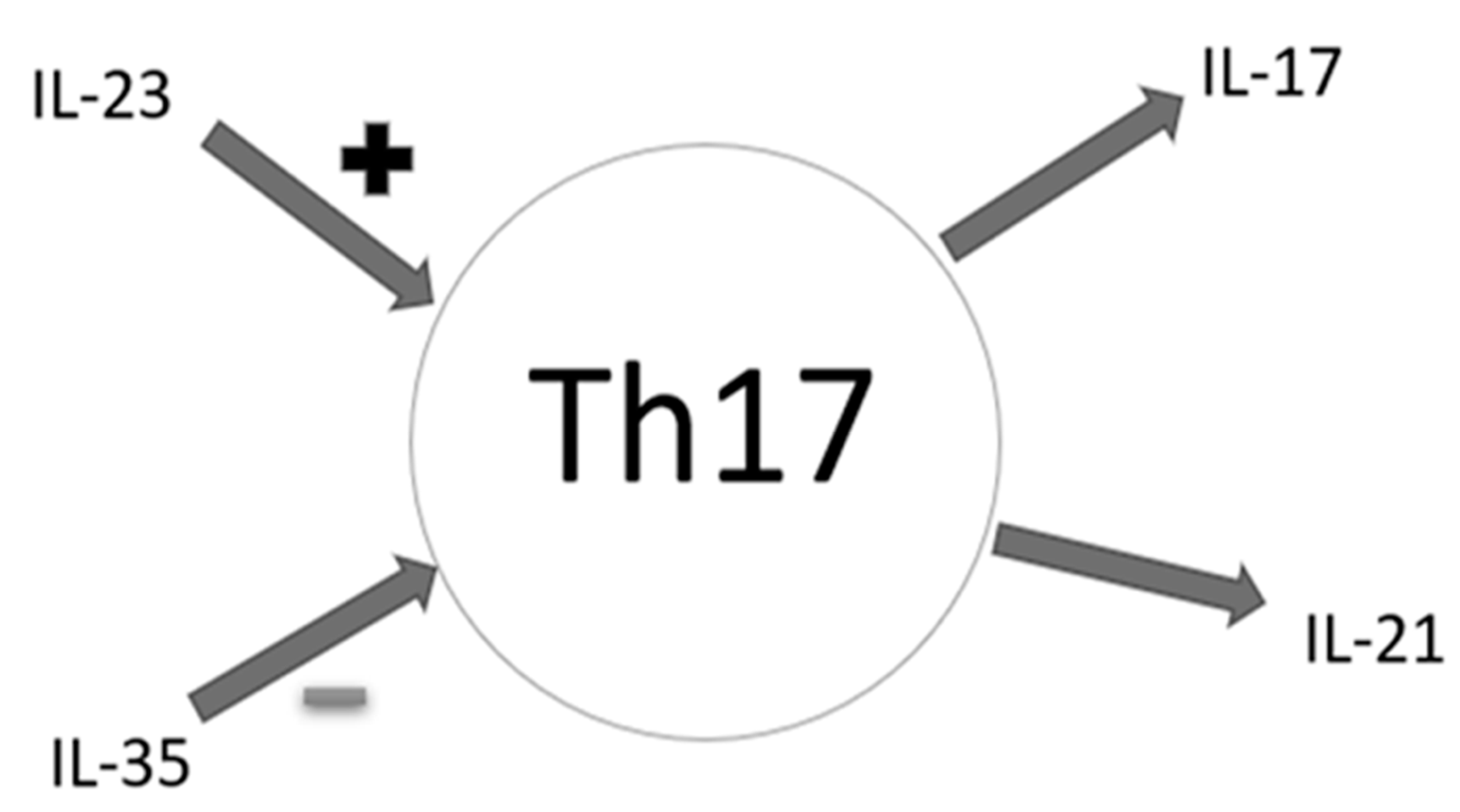Inflammatory versus Anti-Inflammatory Profiles in Major Depressive Disorders—The Role of IL-17, IL-21, IL-23, IL-35 and Foxp3
Abstract
1. Introduction
2. Materials and Methods
2.1. Participants
2.2. Safety and Exclusion Criteria
2.3. Method for Assessing Depression Severity
2.4. Method for Assessing Biological Parameters
2.4.1. Protein Concentration
2.4.2. Enzyme-Linked Immunosorbent Assay (ELISA)
2.4.3. Isolation of Total RNA
2.4.4. Isolated RNA Quality Analysis
2.4.5. RT-PCR Reverse Transcription
2.4.6. Real-Time PCR Reaction
2.5. Statistical Analysis
3. Results
4. Discussion
4.1. Interleukin 17 (IL-17)
4.2. Interleukin 23 (IL-23)
4.3. Interleukin 21 (IL-21)
4.4. Interleukin 35 (IL-35)
4.5. Foxp3
5. Conclusions
Author Contributions
Funding
Institutional Review Board Statement
Informed Consent Statement
Data Availability Statement
Acknowledgments
Conflicts of Interest
References
- Spijker, J.; De Graaf, R.; Bijl, R.V.; Beekman, A.T.F.; Ormel, J.; Nolen, W.A. Functional disability and depression in the general population. Results from the Netherlands Mental Health Survey and Incidence Study (NEMESIS). Acta Psychiatr. Scand. 2004, 110, 208–214. [Google Scholar] [CrossRef] [PubMed]
- Üstün, T.B.; Ayuso-Mateos, J.L.; Chatterji, S.; Mathers, C.; Murray, C.J.L. Global burden of depressive disorders in the year 2000. Br. J. Psychiatry 2004, 184, 386–392. [Google Scholar] [CrossRef] [PubMed]
- Katon, W.; Ciechanowski, P. Impact of major depression on chronic medical illness. J. Psychosom. Res. 2002, 53, 859–863. [Google Scholar] [CrossRef]
- Moussavi, S.; Chatterji, S.; Verdes, E.; Tandon, A.; Patel, V.; Ustun, B. Depression, chronic diseases, and decrements in health: Results from the World Health Surveys. Lancet 2007, 370, 851–858. [Google Scholar] [CrossRef]
- Docherty, A.; Edwards, A.C.; Yang, F.; Peterson, R.E.; Sawyers, C.; Adkins, D.E.; Moore, A.A.; Webb, B.T.; Bacanu, S.A.; Flint, J.; et al. Age of onset and family history as indicators of polygenic risk for major depression. Depression Anxiety 2017, 34, 446–452. [Google Scholar] [CrossRef]
- Andrade, L.; Caraveo-Anduaga, J.J.; Berglund, P.A.; Bijl, R.V.; De Graaf, R.; Vollebergh, W.; Dragomirecka, E.; Kohn, R.; Keller, M.; Kessler, R.C.; et al. The epidemiology of major depressive episodes: Results from the International Consortium of Psychiatric Epidemiology (ICPE) surveys. Int. J. Methods Psychiatr. Res. 2003, 12, 3–21. [Google Scholar] [CrossRef]
- Baca-Garcia, E.; Perez-Rodriguez, M.M.; Sastre, C.D.; Saiz-Ruiz, J.; De Leon, J. Suicidal behavior in schizophrenia and depression: A comparison. Schizophr. Res. 2005, 75, 77–81. [Google Scholar] [CrossRef]
- Liu, Y.; Tang, X. Depressive Syndromes in Autoimmune Disorders of the Nervous System: Prevalence, Etiology, and Influence. Front. Psychiatry 2018, 9, 451. [Google Scholar] [CrossRef]
- A Vallerand, I.; Lewinson, R.T.; Frolkis, A.D.; Lowerison, M.W.; Kaplan, G.G.; Swain, M.G.; Bulloch, A.G.M.; Patten, S.B.; Barnabe, C. Depression as a risk factor for the development of rheumatoid arthritis: A population-based cohort study. RMD Open 2018, 4, e000670. [Google Scholar] [CrossRef]
- Razaz, N.; Tremlett, H.; Marrie, R.A.; Joseph, K.S. Peripartum depression in parents with multiple sclerosis and psychiatric disorders in children. Mult. Scler. J. 2016, 22, 1830–1840. [Google Scholar] [CrossRef]
- Maes, M.; Berk, M.; Goehler, L.E.; Song, C.; Anderson, G.; Gałecki, P.; Leonard, B. Depression and sickness behavior are Janus-faced responses to shared inflammatory pathways. BMC Med. 2012, 10, 66. [Google Scholar] [CrossRef] [PubMed]
- Gałecki, P. Peripheral markers of inflammation, oxidative & nitrosative stress pathways and memory functions as a new target of pharmacotherapy in depression. Prog. Neuro Psychopharmacol. Biol. Psychiatry 2018, 80, 167. [Google Scholar] [CrossRef]
- Kowalczyk, M.; Szemraj, J.; Bliźniewska, K.; Maes, M.; Berk, M.; Su, K.-P.; Gałecki, P. An immune gate of depression – Early neuroimmune development in the formation of the underlying depressive disorder. Pharmacol. Rep. 2019, 71, 1299–1307. [Google Scholar] [CrossRef] [PubMed]
- Uysal, S. ICD-10-CM Diagnosis Coding for Neuropsychological Assessment. Arch. Clin. Neuropsychol. 2018, 34, 721–730. [Google Scholar] [CrossRef]
- Hamilton, M. A RATING SCALE FOR DEPRESSION. J. Neurol. Neurosurg. Psychiatry 1960, 23, 56–62. [Google Scholar] [CrossRef]
- Schmittgen, T.D.; Livak, K.J. Analyzing real-time PCR data by the comparative CT method. Nat. Protoc. 2008, 3, 1101–1108. [Google Scholar] [CrossRef]
- Livak, K.J.; Schmittgen, T.D. Analysis of relative gene expression data using real-time quantitative PCR and the 2−ΔΔCT Method. Methods 2001, 25, 402–408. [Google Scholar] [CrossRef]
- Maurice, G. Kendall: Rank Correlation Methods; Charles Griffin & Company Limited: London, UK, 1948. [Google Scholar]
- Pryce, C.R.; Fontana, A. Depression in Autoimmune Diseases. Curr. Top. Behav. Neurosci. 2016, 31, 139–154. [Google Scholar] [CrossRef]
- Loft, N.; Halling, A.-S.; Egeberg, A.; Skov, L. Efficacy of a second interleukin 17 inhibitor in patients with psoriasis: A systematic review and meta-analysis. J. Am. Acad. Dermatol. 2021, 84, 130–138. [Google Scholar] [CrossRef]
- Blanco, F.J.; Möricke, R.; Dokoupilova, E.; Codding, C.; Neal, J.; Andersson, M.; Rohrer, S.; Richards, H. Secukinumab in Active Rheumatoid Arthritis: A Phase III Randomized, Double-Blind, Active Comparator– and Placebo-Controlled Study. Arthritis Rheumatol. 2017, 69, 1144–1153. [Google Scholar] [CrossRef]
- Krueger, J.G.; Brunner, P.M. Interleukin-17 alters the biology of many cell types involved in the genesis of psoriasis, systemic inflammation and associated comorbidities. Exp. Dermatol. 2018, 27, 115–123. [Google Scholar] [CrossRef] [PubMed]
- Mathew, A.J.; Chandran, V. Depression in Psoriatic Arthritis: Dimensional Aspects and Link with Systemic Inflammation. Rheumatol. Ther. 2020, 7, 287–300. [Google Scholar] [CrossRef] [PubMed]
- Kurd, S.K.; Troxel, A.B.; Crits-Christoph, P.; Gelfand, J.M. The risk of depression, anxiety, and suicidality in patients with psoriasis: A population-based cohort study. Arch. Dermatol. 2010, 146, 891–895. [Google Scholar] [PubMed]
- Basavaraj, K.H.; Ashok, N.M.; Rashmi, R.; Praveen, T.K. The role of drugs in the induction and/or exacerbation of psoriasis. Int. J. Dermatol. 2010, 49, 1351–1361. [Google Scholar] [CrossRef] [PubMed]
- Esposito, M.; Giunta, A.; Del Duca, E.; Manfreda, V.; Troisi, A.; Bianchi, L.; Fargnoli, M.C. Long-term safety and efficacy of secukinumab in patients with psoriasis and major psychiatric disorders: A case series. Postgrad. Med. 2020, 132, 172–175. [Google Scholar] [CrossRef] [PubMed]
- AlBeltagy, E.S.; Elaziz, S.Y.A.; Abozaid, S.Y.; El Zomor, H.M.; Elhamed, S.S.A. Interleukin 6, interleukin 17, disease-related and contextual factor association with depression, and its severity in patients with rheumatoid arthritis. Clin. Rheumatol. 2020, 1–10. [Google Scholar] [CrossRef]
- Li, Y.-C.; Chou, Y.-C.; Chen, H.-C.; Lu, C.-C.; Chang, D.-M. Interleukin-6 and interleukin-17 are related to depression in patients with rheumatoid arthritis. Int. J. Rheum. Dis. 2019, 22, 980–985. [Google Scholar] [CrossRef]
- Winer, S.; Paltser, G.; Chan, Y.; Tsui, H.; Engleman, E.; Winer, D.; Dosch, H.-M. Obesity predisposes to Th17 bias. Eur. J. Immunol. 2009, 39, 2629–2635. [Google Scholar] [CrossRef]
- Zhou, L.; Lopes, J.E.; Chong, M.M.; Ivanov, I.I.; Min, R.; Victora, G.D.; Shen, Y.; Du, J.; Rubtsov, Y.P.; Rudensky, A.Y.; et al. TGF-b-induced Foxp3 inhibits T(H)17 cell differentiation by antagonizing RORgammat function. Nature 2008, 453, 236–240. [Google Scholar] [CrossRef]
- Chen, Y.; Jiang, T.; Chen, P.; Ouyang, J.; Xu, G.; Zeng, Z.; Sun, Y. Emerging tendency towards autoimmune process in major depressive patients: A novel insight from Th17 cells. Psychiatry Res. 2011, 188, 224–230. [Google Scholar] [CrossRef]
- Davami, M.H.; Baharlou, R.; Ahmadi Vasmehjani, A.; Ghanizadeh, A.; Keshtkar, M.; Dezhkam, I.; Atashzar, M.R. Elevated IL-17 and TGF-beta serum levels: A positive correlation between T-helper 17 cell-related pro-inflammatory re-sponses with major depressive disorder. Basic Clin. Neurosci. 2016, 7, 137–142. [Google Scholar] [PubMed]
- Zhang, Y.; Zhen, H.; Yao, W.; Bian, F.; Mao, X.; Yang, X.; Jin, S. Antidepressant Drug, Desipramine, Alleviates Allergic Rhinitis by Regulating Treg and Th 17 Cells. Int. J. Immunopathol. Pharmacol. 2013, 26, 107–115. [Google Scholar] [CrossRef] [PubMed]
- Kim, J.-W.; Kim, Y.-K.; Hwang, J.-A.; Yoon, H.-K.; Ko, Y.-H.; Han, C.; Lee, H.-J.; Ham, B.-J.; Lee, H.-S. Plasma Levels of IL-23 and IL-17 before and after Antidepressant Treatment in Patients with Major Depressive Disorder. Psychiatry Investig. 2013, 10, 294–299. [Google Scholar] [CrossRef]
- Liu, Y.; Ho, R.; Mak, A. The role of interleukin (IL)-17 in anxiety and depression of patients with rheumatoid arthritis. Int. J. Rheum. Dis. 2012, 15, 183–187. [Google Scholar] [CrossRef] [PubMed]
- Tang, C.; Chen, S.; Qian, H.; Huang, W. Interleukin-23: As a drug target for autoimmune inflammatory diseases. Immunol. 2012, 135, 112–124. [Google Scholar] [CrossRef]
- Lupardus, P.J.; Garcia, K.C. The Structure of Interleukin-23 Reveals the Molecular Basis of p40 Subunit Sharing with Interleukin-12. J. Mol. Biol. 2008, 382, 931–941. [Google Scholar] [CrossRef] [PubMed]
- Gerosa, F.; Baldani-Guerra, B.; Lyakh, L.A.; Batoni, G.; Esin, S.; Winkler-Pickett, R.T.; Consolaro, M.R.; De Marchi, M.; Giachino, D.; Robbiano, A.; et al. Differential regulation of interleukin 12 and interleukin 23 production in human dendritic cells. J. Exp. Med. 2008, 205, 1447–1461. [Google Scholar] [CrossRef]
- Langrish, C.L.; McKenzie, B.S.; Wilson, N.J.; Malefyt, R.D.W.; Kastelein, R.A.; Cua, D.J. IL-12 and IL-23: Master regulators of innate and adaptive immunity. Immunol. Rev. 2004, 202, 96–105. [Google Scholar] [CrossRef]
- McKenzie, B.S.; Kastelein, R.A.; Cua, D.J. Understanding the IL-23–IL-17 immune pathway. Trends Immunol. 2006, 27, 17–23. [Google Scholar] [CrossRef]
- Langrish, C.L.; Chen, Y.; Blumenschein, W.M.; Mattson, J.; Basham, B.; Sedgwick, J.D.; McClanahan, T.; Kastelein, R.A.; Cua, D.J. IL-23 drives a pathogenic T cell population that induces autoimmune inflammation. J. Exp. Med. 2005, 201, 233–240. [Google Scholar] [CrossRef]
- Ovčina-Kurtović, N.; Halilovic, E.K. Serum Concentrations of Interferon Gamma (IFN- and #947;) in Patients with Psoriasis: Correlation with Clinical Type and Severity of the Disease. Med Arch. 2018, 72, 410–413. [Google Scholar] [CrossRef]
- Blauvelt, A.; Chiricozzi, A. The Immunologic Role of IL-17 in Psoriasis and Psoriatic Arthritis Pathogenesis. Clin. Rev. Allergy Immunol. 2018, 55, 379–390. [Google Scholar] [CrossRef] [PubMed]
- Savage, L.J.; Wittmann, M.; McGonagle, D.; Helliwell, P.S. Ustekinumab in the Treatment of Psoriasis and Psoriatic Arthritis. Rheumatol. Ther. 2015, 2, 1–16. [Google Scholar] [CrossRef] [PubMed][Green Version]
- Baldo, B.A. Drugs that Act on the Immune System: Cytokines and Monoclonal Antibodies. In Side Effects of Drugs Annual; Sidhartha, R., Ed.; Elsevier: Amsterdam, The Netherlands, 2014; Volume 36, pp. 561–590. [Google Scholar]
- Langley, R.G.; Feldman, S.R.; Han, C.; Schenkel, B.; Szapary, P.; Hsu, M.-C.; Ortonne, J.-P.; Gordon, K.B.; Kimball, A.B. Ustekinumab significantly improves symptoms of anxiety, depression, and skin-related quality of life in patients with moderate-to-severe psoriasis: Results from a randomized, double-blind, placebo-controlled phase III trial. J. Am. Acad. Dermatol. 2010, 63, 457–465. [Google Scholar] [CrossRef]
- Kim, S.-J.; Park, M.; Pak, K.; Han, J.; Kim, G.-W.; Kim, H.-S.; Ko, H.-C.; Kim, M.-B.; Kim, B.-S. Improvement of depressive symptoms in patients with moderate-to-severe psoriasis treated with ustekinumab: An open label trial validated using beck depression inventory, Hamilton depression rating scale measures and 18fluorodeoxyglucose (FDG) positron emission tomography (PET). J. Dermatol. Treat. 2018, 29, 761–768. [Google Scholar] [CrossRef]
- Awasthi, A.; Kuchroo, V.K. IL-17A directly inhibits TH1 cells and thereby suppresses development of intestinal in-flammation. Nat. Immunol. 2009, 10, 568–570. [Google Scholar] [CrossRef]
- Juszczak, M.; Głabiński, A. Udział limfocytów Th17 w patogenezie stwardnienia rozsianego [Th17 cells in the pathogenesis of multiple sclerosis]. Postepy. Hig. Med. Dosw. 2009, 23, 492–501. [Google Scholar]
- Winkler, I.; Gogacz, M.; Rechberger, T. Czy limfocyty Th17 odgrywaja istotna role w etiopatogenezie i rokowaniu raka jajnika? [Do Th17 cells play an important role in the pathogenesis and prognosis of ovarian cancer?]. Ginekol. Pol. 2012, 83, 295–300. [Google Scholar]
- Long, D.; Chen, Y.; Wu, H.; Zhao, M.; Lu, Q. Clinical significance and immunobiology of IL-21 in autoimmunity. J. Autoimmun. 2019, 99, 1–14. [Google Scholar] [CrossRef]
- Davami, M.H.; Baharlou, R.; Vasmehjani, A.A.; Ghanizadeh, A.; Keshtkar, M.; Dezhkam, I.; Atashzar, M.R. Elevated IL-17 and TGF-β Serum Levels: A Positive Correlation between T-helper 17 Cell-Related Pro-Inflammatory Responses with Major Depressive Disorder. Basic Clin. Neurosci. J. 2016, 7, 137–142. [Google Scholar] [CrossRef]
- Kochetkova, I.; Golden, S.; Holderness, K.; Callis, G.; Pascual, D.W. IL-35 Stimulation of CD39+ Regulatory T Cells Confers Protection against Collagen II-Induced Arthritis via the Production of IL-10. J. Immunol. 2010, 184, 7144–7153. [Google Scholar] [CrossRef] [PubMed]
- Liu, J.-Q.; Liu, Z.; Zhang, X.; Shi, Y.; Talebian, F.; Carl, J.W.; Yu, C.; Shi, F.-D.; Whitacre, C.C.; Trgovcich, J.; et al. Increased Th17 and Regulatory T Cell Responses in EBV-Induced Gene 3-Deficient Mice Lead to Marginally Enhanced Development of Autoimmune Encephalomyelitis. J. Immunol. 2012, 188, 3099–3106. [Google Scholar] [CrossRef] [PubMed]
- Whitehead, G.S.; Wilson, R.H.; Nakano, K.; Burch, L.H.; Nakano, H.; Cook, D.N. IL-35 production by inducible costimulator (ICOS)–positive regulatory T cells reverses established IL-17–dependent allergic airways disease. J. Allergy Clin. Immunol. 2012, 129, 207–215.e5. [Google Scholar] [CrossRef] [PubMed]
- Zhang, L.; Zhao, Y. The regulation of Foxp3 expression in regulatory CD4 +CD25 +T cells: Multiple pathways on the road. J. Cell. Physiol. 2007, 211, 590–597. [Google Scholar] [CrossRef]
- Taylor, M.R.; Roby, C.R.; Elziny, S.; Duricy, E.; Taylor, T.M.; Bowers, J.M. Age, but Not Sex, Modulates Foxp3 Expression in the Rat Brain across Development. Neurosci. 2020, 442, 87–99. [Google Scholar] [CrossRef]
- Maes, M.; Carvalho, A.F. The Compensatory Immune-Regulatory Reflex System (CIRS) in Depression and Bipolar Disorder. Mol. Neurobiol. 2018, 55, 8885–8903. [Google Scholar] [CrossRef]



| Protein Expression (ng/mL) | Study Group | Control Group | t | p | ||||||
|---|---|---|---|---|---|---|---|---|---|---|
| M | Min | Max | SD | M | Min | Max | SD | |||
| IL-17 | 283.73 | 121.00 | 473.00 | 83.39 | 100.80 | 44.00 | 143.00 | 24.68 | 21.43 | 0.000 * |
| IL-21 | 155.98 | 79.00 | 251.00 | 39.81 | 362.42 | 228.00 | 452.00 | 52.65 | −37.43 | 0.000 * |
| IL-23 | 447.66 | 178.00 | 734.00 | 110.08 | 151.11 | 92.00 | 241.00 | 35.76 | 26.20 | 0.000 * |
| IL-35 | 115.53 | 43.00 | 265.00 | 46.06 | 342.99 | 156.00 | 476.00 | 77.16 | −31.40 | 0.000 * |
| Foxp3 | 3.62 | 1.26 | 9.63 | 1.12 | 7.58 | 3.34 | 9.51 | 1.35 | −26.60 | 0.000 * |
| mRNA Gene Expression (2−Δct) | Study Group | Control Group | t | p | ||||||
|---|---|---|---|---|---|---|---|---|---|---|
| M | Min | Max | SD | M | Min | Max | SD | |||
| IL-17 | 0.52 | 0.20 | 0.63 | 0.07 | 0.23 | 0.05 | 0.39 | 0.06 | 33.96 | 0.000 * |
| IL-21 | 0.18 | 0.07 | 0.38 | 0.06 | 0.41 | 0.28 | 0.49 | 0.05 | −32.92 | 0.000 * |
| IL-23 | 0.61 | 0.30 | 0.75 | 0.06 | 0.27 | 0.18 | 0.40 | 0.05 | 45.67 | 0.000 * |
| IL-35 | 0.22 | 0.11 | 0.45 | 0.07 | 0.49 | 0.13 | 0.61 | 0.08 | −29.91 | 0.000 * |
| Foxp3 | 0.11 | 0.06 | 0.18 | 0.02 | 0.21 | 0.12 | 0.26 | 0.03 | −29.60 | 0.000 * |
| Correlation of Age and Expression of Genes for the Control Group | ||||||||||
| IL 17 Protein | IL 17 mRNA | IL 21 Protein | IL 21 mRNA | IL 23 Protein | IL 23 mRNA | IL 35 Protein | IL 35 mRNA | Foxp3 Protein | Foxp3 mRNA | |
| r | 0.2437 | 0.3098 | −0.3101 | −0.3110 | 0.0392 | 0.0282 | 0.1470 | 0.1293 | −0.0223 | −0.0399 |
| p | 0.015 * | 0.002 * | 0.002 * | 0.002 * | 0.700 | 0.782 | 0.147 | 0.202 | 0.827 | 0.695 |
| Correlation of Age and Expression of Genes for All Participants | ||||||||||
| r | 0.5329 | 0.6235 | −0.6268 | 0.6118 | 0.5677 | 0.6257 | −0.5420 | −0.5313 | −0.5776 | −0.5863 |
| p | 0.000 * | 0.000 * | 0.000 * | 0.000 * | 0.000 * | 0.000 * | 0.000 * | 0.000 * | 0.000 * | 0.000 * |
Publisher’s Note: MDPI stays neutral with regard to jurisdictional claims in published maps and institutional affiliations. |
© 2021 by the authors. Licensee MDPI, Basel, Switzerland. This article is an open access article distributed under the terms and conditions of the Creative Commons Attribution (CC BY) license (http://creativecommons.org/licenses/by/4.0/).
Share and Cite
Gałecka, M.; Bliźniewska-Kowalska, K.; Orzechowska, A.; Szemraj, J.; Maes, M.; Berk, M.; Su, K.-P.; Gałecki, P. Inflammatory versus Anti-Inflammatory Profiles in Major Depressive Disorders—The Role of IL-17, IL-21, IL-23, IL-35 and Foxp3. J. Pers. Med. 2021, 11, 66. https://doi.org/10.3390/jpm11020066
Gałecka M, Bliźniewska-Kowalska K, Orzechowska A, Szemraj J, Maes M, Berk M, Su K-P, Gałecki P. Inflammatory versus Anti-Inflammatory Profiles in Major Depressive Disorders—The Role of IL-17, IL-21, IL-23, IL-35 and Foxp3. Journal of Personalized Medicine. 2021; 11(2):66. https://doi.org/10.3390/jpm11020066
Chicago/Turabian StyleGałecka, Małgorzata, Katarzyna Bliźniewska-Kowalska, Agata Orzechowska, Janusz Szemraj, Michael Maes, Michael Berk, Kuan-Pin Su, and Piotr Gałecki. 2021. "Inflammatory versus Anti-Inflammatory Profiles in Major Depressive Disorders—The Role of IL-17, IL-21, IL-23, IL-35 and Foxp3" Journal of Personalized Medicine 11, no. 2: 66. https://doi.org/10.3390/jpm11020066
APA StyleGałecka, M., Bliźniewska-Kowalska, K., Orzechowska, A., Szemraj, J., Maes, M., Berk, M., Su, K.-P., & Gałecki, P. (2021). Inflammatory versus Anti-Inflammatory Profiles in Major Depressive Disorders—The Role of IL-17, IL-21, IL-23, IL-35 and Foxp3. Journal of Personalized Medicine, 11(2), 66. https://doi.org/10.3390/jpm11020066






